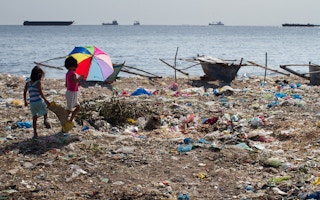Global beverage firm Coca-Cola and packaging company Indorama Ventures have ignited controversy by claiming that polyethylene terephthalate (PET) bottles are not single-use packaging.
To continue reading, subscribe to Eco‑Business.
There's something for everyone. We offer a range of subscription plans.
- Access our stories and receive our Insights Weekly newsletter with the free EB Member plan.
- Unlock unlimited access to our content and archive with EB Circle.
- Publish your content with EB Premium.
Environmental activists have disputed the claim, arguing that both companies’ PET recycling facility does not change the fact that PET bottles are largely discarded after being used only once. And unlike other materials like aluminium or glass, PET can only be recycled a certain number of times.
Coca-Cola and Indorama signed a deal this month for the US$19 million facility, slated for completion in 2021 in Cavite province, southwest of Manila. Touted as the Philippines’ largest bottle-to-bottle recycling plant, it will process 30,000 metric tonnes of used plastic—or nearly 2 billion clear plastic bottles—and produce 16,000 metric tonnes of recycled PET resin a year.
Coca-Cola, one of the world’s biggest producers of plastic waste, did not disclose the amount of PET bottles used for products it sells in the Philippines annually. But in a study of litter found on beaches, streets, homes, and parks in 50 countries last year, the Philippines was where the biggest chunk of Coke-branded trash was found. PET bottles made up more than 60 per cent of the waste.
The archipelago accounts for 5.9 per cent of the total plastic trash in the world’s oceans and single-use plastic is blamed for clogging its waterways and dumpsites.
In a statement announcing the joint venture, the companies said used PET plastic bottles are 100 per cent recyclable and are therefore not single-use. They said the facility will ensure the plastic is “collected, processed and used again and again within a circular economy”.
Gareth McGeown, chief executive officer of Coca-Cola Beverages Philippines, said the new facility would produce the country’s “first-ever beverage bottle made from 100 per cent recycled plastic”.
Calling both companies’ claim “ridiculous”, Greenpeace Philippines’ country director Lea Guerrero said PET bottles are very much a part of the single-use model because they are discarded after being used once and sent to the recycling plant.
Coca-Cola’s proposed recycling plan is also carbon-intensive, requiring water and energy and resulting in toxic effluents and emissions, she added.
“
Even if PET bottles can be recycled, it still follows the single-use model because the bottle was discarded and sent to the recycling plant after being used only once.
Lea Guerrero, country director, Greenpeace Philippines
Sonia Mendoza, chairwoman of Mother Earth Foundation, a Philippine-based non-profit known for advocating zero waste programmes in Southeast Asia, agreed.
“Recycled PET bottles are still considered single-use. Besides, even recyclable plastic has a limit to its recyclability, not like glass that is infinitely recyclable,” said Mendoza.
Lack of waste segregation and collection facilities
Responding to Eco-Business, Indorama Ventures pointed out that the European Union does not recognise PET plastic as single-use packaging, and mandates that a portion of all drinks containers of its member states be made from recycled PET in future.
“The energy (used to make) glass bottles and aluminium cans is higher than PET and recycled PET, which not only uses far less energy to produce, but also to use, throughout its life cycle,” said Richard Jones, senior vice-president of Indorama Ventures.
“The weight of glass means using more petrol gasoline in its delivery, and this is a significant source of greenhouse gases. It’s important to know that current biodegradable products can only decompose if they are sent to a special factory where the temperature and humidity are specially controlled.”
PET has become the most favoured packaging material worldwide for beverages because it is unbreakable and lightweight compared to glass bottles. Earlier this year, Coca-Cola—which aims to collect and recycle the equivalent of every bottle and can it sells by 2030—said it had no plans to shift away from plastic bottles because consumers prefer them.
The new recycling facility will need new or virgin plastic feedstock to maximise operations, and this entails the extraction of more fossil fuels, said Guerrero.
“Recycling can cause a surge in plastic,” said the veteran campaigner. “It’s in Coke’s interest that the manufacturing of PET bottles increases, and this goes along with the jump in manufacturing of plastic and the extraction of more petroleum in order to keep all this going.”
While Coca-Cola’s recycling facility is a “big step towards diverting plastic from the ocean”, Mother Earth’s Mendoza said the collection of used bottles is worrisome, as the country has a poor garbage segregation system that mixes recyclables with other waste.
Mendoza said although the foundation’s zero waste programme can collect recyclables directly from households and temporarily store them in materials recovery facilities, there are insufficient facilities in barangays, or districts in each city.
“Sadly, only 25 per cent of the country’s 42,000 barangays have materials recovery facilities. If Coke wants to efficiently collect their PET bottles for recycling, they would really have to partner with the local government units,” she said.








